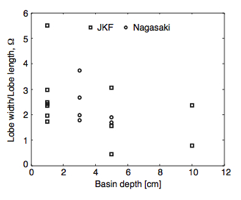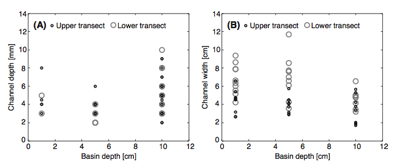Reports: DNI850793-DNI8: Decoupling Tectonic and Autogenic Controls on the Development of Cyclic Fluvial Strata: Flume Experiments
Wonsuck Kim, PhD, University of Texas at Austin

Figure Figure 2: Laterally-averaged shoreline position against time. Autogenic sediment release events as times of increased progradation rates are indicted by arrows.
Figure 3: Channel geometry in the current experiments was may have been influenced by the processes on the delta foreset. The longer foreset in the deep basin allowed a sediment bypass system to develop and lock the channel in place. Channel avulsion that releases fine sediment also produces a strong locking mechanism. This focused flow further narrowed and deepened the channel and produced a narrow and elongated lobe. Future work to capture changes in foreset slope processes under varying basin depth would greatly enhance our understanding of the control of basin depth on the fluvial autogenic timescale.
Figure 4: A) Channel depths and B) width measured at upper and lower transects. Measurements were collected from topography scan collected during channelized flow (i.e., sediment release event).














